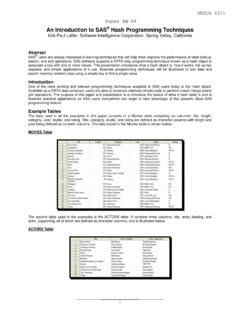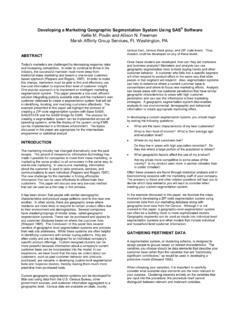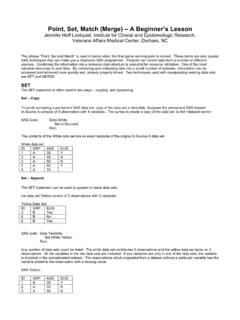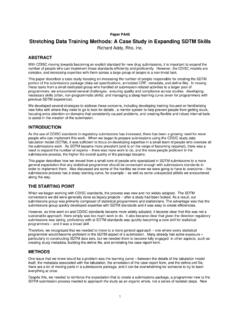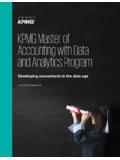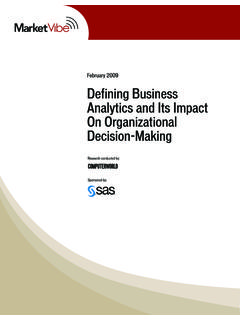Transcription of SDTM What? ADaM Who? - Institute for Advanced …
1 1 Paper PH-90 sdtm What? ADaM Who? A Programmer s Introduction to CDISC Venita DePuy, Bowden analytics ABSTRACT Most programmers in the pharmaceutical industry have at least heard of CDISC, but may not be familiar with the overall data structure, naming conventions, and variable requirements for sdtm and ADaM datasets. This overview will provide a general introduction to CDISC from a programing standpoint, including the creation of the standard sdtm domains and supplemental datasets, and subsequent creation of ADaM datasets. Time permitting, we will also discuss when it might be preferable to do a CDISC-like dataset instead of a dataset that fully conforms to CDISC standards. INTRODUCTION CDISC is the Clinical Data Interchange Standards Consortium ( ), whose mission is to develop and support platform-independent data standards.
2 While they have also developed other guidelines, such as for data collection (Clinical Data Acquisition Standards Harmonization, CDASH), this paper focusses on the Study Data Tabulation Model ( sdtm ) and Analysis Data Model (ADaM) structures. In simple terms, CDISC s goal is to provide a standard data layout, across different companies and different systems. In 2004, the FDA announced that they preferred to receive data in CDISC sdtm format. In September 2013, the FDA announced that they would require study data in conformance to CDISC standards in the near future. As a result, there is more and more demand for CDISC-compliant datasets by the pharmaceutical and medical device companies. Furthermore, if individual studies use CDISC, it is relatively straightforward to combine the datasets across trials to do the Integrated Summaries of Safety and Efficacy (ISS and ISE) to support a New Drug Application (NDA).
3 At a recent (September 2014) seminar I attended, a CDISC representative indicated that the FDA was expected set a date (possibly by the end of 2014), and that any study beginning more than 2 years after that date would be required to submit datasets to the FDA in CDISC format. While CDISC format is not absolutely required for FDA submissions as of yet, it is certainly recommended. It can decrease FDA review time and subsequently decrease time to market. It is also cheaper to do CDISC initially, than to retroactively create CDISC datasets for past studies in preparation for an NDA filing. Some of the advantages of CDISC are: - Standardized dataset names and layout - Standardized variable naming conventions - Standardized calculations for things such as study day, percent change from baseline, and other common variables.
4 Once a programmer or statistician is familiar with the CDISC layout, it decreases the time to become familiar with a new study. If you start working on a project that you know is in CDISC, you automatically know that the lab dataset is called LB, and the numeric test result in standard units is LBSTRESN, and that your hemoglobin result will have LBCAT= HEMATOLOGY and LBTESTCD= HGB and LBTEST= HEMOGLOBIN , with standardized units in LBSTRESU. This paper is not intended to be a comprehensive reference, but is instead meant to be an introductory overview to CDISC from a programming perspective, based on my personal experience working as both a statistician and a programmer for pharmaceutical companies and clinical research organizations.
5 There are many more sdtm domains, and many more standardized variables, than are discussed herein. I have tried to focus on key variables in sdtm domains that are modified when creating ADaM datasets, and how those variables change between the two. Key reference documents are given at the end of this document. OVERVIEW In simple terms, sdtm datasets are raw data and ADaM datasets are the analysis datasets. It is most efficient to create sdtm datasets, then ADaM datasets, then the display outputs (tables, listings, and figures [TLFs]) based on the ADaM datasets. 2 sdtm datasets, in general, have 1 record per subject per visit per assessment; for example, the dataset of laboratory results (LB) will have 1 record per subject per visit per laboratory test.
6 The original laboratory results, from the lab, might be in the form of 1 record per subject per visit (with different variables for each test), which would need transposed to incorporate into the sdtm format, or may be in a sdtm format already (which is definitely easier to work with, in my opinion). Other datasets might have one record per person (demographics, DM) or one record per subject, visit, questionnaire, and questionnaire item (for efficacy assessments). Variable names are standardized, the possible values for those variables are often standardized using controlled terminology, and derivations may be standardized. For instance, in sdtm , original laboratory results, vital signs results, or questionnaire results will be in a variable called --ORRES, where -- is the domain name: LB, VS, or QS respectively.
7 Since values may be reported in different units (such as weight being in kilograms or pounds), standardized values are in --STRESC (for character values) and/or --STRESN (for numeric values). The subsequent ADaM datasets use Analysis Values (AVAL for numeric, AVALC for character), which - in the absence of any other derivations, imputations, etc. - are as simple as AVAL = --STRESN and AVALC = --STRESC. This makes it straightforward to produce tables, summarizing AVAL by timepoint and treatment group. It is important to note that the same variable should have the same attributes across different datasets. VISIT should have the same length in all sdtm datasets, PARAM should have the same length in all ADaM datasets, and so forth.
8 sdtm The sdtm model groups domains (datasets) into 3 general types: The Findings class captures the results of planned observations, such as ECG results or questionnaires. The Interventions class captures things that were done to subjects, such as treatments administered. The Events class captures things that occurred (such as adverse events or medical history) and protocol milestones ( , randomization and study completion). In addition, the Special Purpose Domain category includes specific data structures that do not fit into the other categories, such as: demographics and subject visits. While there are additional special purpose domains, such as Trial Arms (TA) that provide descriptive information about the overall study, the scope of this paper is limited to datasets that contain information on individual subjects.
9 While only a limited number of datasets are discussed herein, many things from laboratory results are applicable to vital signs, ECG, physical exams, questionnaires, etc. The Findings class includes: Drug Accountability (DA), including dispense and return records Electrocardiogram (EG) captures ECG results Inclusion/Exclusion Criteria Not Met (IE) does not list all criteria for all subjects, just the criteria which were not met. Laboratory test results (LB) such as hematology, chemistry, and urinalysis (excluding pharmacokinetic or microbiology) Physical examination results (PE) Questionnaires (QS) provides a standard format for a variety of instruments, such as the SF-36. Vital Signs (VS), including blood pressure, temperature, height, and weight The Interventions class includes: Concomitant Medications (CM) this typically includes non-study medications and therapies, regardless of when they were taken ( , not just concomitant medications) Exposure Domains: Exposure (EX), which includes treatment administration but not dispense/return records The Events class includes: Adverse events (AE) Clinical events (CE), which captures clinical events of interest that may not typically be classified as adverse events.
10 For example, a cardiology study might look at clinical events such as heart transplant, hospitalization for heart failure, ventricular assistive device (VAD) insertion, myocardial infarction, stroke, cardiac death, and non-cardiac death. 3 Disposition (DS), which captures not only study completion or early termination, but also protocol-defined time points such as informed consent, randomization, and entry into a long-term follow-up period. GENERAL VARIABLE STRUCTURE FOR sdtm DATASETS The sdtm Implementation Guide (SDTMIG) lists which variables are required, expected, or permissible (either optional, or whose requirement depends on study characteristics) for each domain. Variable names, labels, types (character or numeric) are specified.

